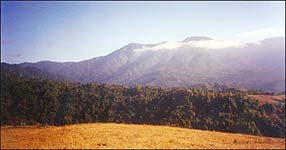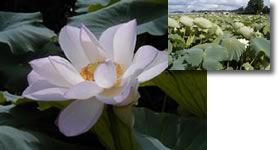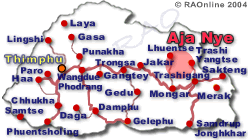|
The
myth and the mystery of Aja Nye
|
 |
Bhutan's
People |
|
 |
Bhutan
Information |
|
|
 |
|
Aja
Nye: A three day walk north of Mongar
|
Sacred
Aja's value and merit shall transcend all human imagination; A mere visit
shall bring peace and happiness; Visualization alone will lead to enlightenment;
Aja is comparable to the western heavenly abode...
Thirteen
centuries after Guru Rinpoche made this prophecy the "value and merit"
of this sacred Buddhist site in Mongar district still holds amystical attraction
to many Bhutanese.
 |
Located
at an altitude of more than 2,500 meters a.s. (base camp areaat about 2,450 meters above sea level, measured with a GPS by Jennifer Chandler, 2012) the sacred hidden
place attributed to Guru Rinpoche is a three-day walk from Mongar dzong.
Its gorges and mountains are dotted with Nyes (sacred sites). |
|
|
The
history of Aja Nye - The legend of Guru Rinpoche
|
 |
The
history of Aja Nyedates back to 850 AD when, according tolegend, Guru
Rinpoche knew that the demon King, Khikharathoed,exiled from Tibet, was
trying to settle in Aja. After suppressing an evil spirit whom he had chased
all the way from Tibet at the Gomphu Kora Nye in Trashiyangtse Guru Rinpoche
traveled throughTormijangsa, crossing several gorges and mountain peaks
to reach Aja.
At
the site, Guru Rinpoche subdued many local evil spirits anddemons but found
it difficult to suppress Khikharathoed. According to religious interpretation,
Khikharathoed escaped from the wrath of the Guru and moved to Khempajong
in Kurtoe where he established his demon kingdom.
It
is believed that Guru Rinpoche spent more than three months hiding sacred
Nyes to be rediscovered in the future. Among the several sacred spots,
the most popular site is a small cave on the bank of Aja Chhuwhere Guru
Rinpoche meditated for three months. Depicting proof of the attainment
of perfection, the last letter "Aa" in the Chokoey alphabet was miraculously
imprinted in white on the reddish-brown rock in the cave after Guru completed
his meditation.
Thus,
the cave derived its name Aja from the 100 Aa printed on the inner wall
of the cave.
"Today,
though not all the letters are visible, those printed boldly can still
be seen," said the prinicpal of the Zorig Chusum Institute in Trashiyangtse,
Lam Kezang Chophel, who has considerable knowledge of Aja as he was born
and grew up in Yarab, a day's walk from Aja.
There
is also a spring water (Menchu) near Aja Chhu believed to have medicinal
values. People frequent the place to bathe in the pungent smelling spring
for medical purposes. It is believed to have acurative effect on 18 diseases
such as tuberculosis, bodyache, ulcer and whooping cough. Located in the
same vicinity is another stream called Awa Chhu. Legend has it that the
stream that falls from the rocky cliff came into existence after Guru's
walking stick was implanted in the rock. The stream falls on a rock basin
forming a pool, where it is believed the Guru had taken bath. The pool
accommodates nine people and a bath in the pool is believed to purify a
person. All visitors sincerely take a dip in the pool which is also believed
to be warm in winter and cool in summer.
There
also exists Tsa Awa Doti, a kind of grass considered sacred and believed
to have medicinal values. It is believed that Guru Rinpoche planted the
grass. The place holds a host of other religious sites and symbols including
Guru's foot prints, body prints, the print of his seat, prints indicating
the subjugation of evil, Khando Dowazangmo's foot prints, 108 retreat caves
of Guru Rinpoche, and the foot prints of Lam Karma Jamyang who discovered
the hidden sacred sites. They are located in mountains, bamboo groves,
meadows, gorges, and dense forests.
It takes a minimum of three days to
complete visits to all these Nyes. "It will still be incomplete if one
doesn't visit Phuning, considered the heart of all the Nyes in the area,"
said Lam Kezang. This place is aday-long walk from Aja and houses various
religious sites attributed to Guru Rinpoche. Located at an altitude of
4,500 meters, it is also a meditation centre for learned Bhutanese lamas.
There is a smallmonastery built by Lam Sonam Zangpo. All the Nyes are miraculous
and the moment you get there your spiritual senses are heightened as if
you are in a heavenly abode, "Karpo, a staff of Mongar dzongkhag who visited
Aja Nye several times.
According
to Namthar (religious history), all the sacred Nyes of Aja were discovered
by Lam Karma Jamyang, a disciple of the Ninth Karmapa. Guru Rinpoche had
actually prophesized that it would be discovered by the Ninth Karmapa.
Old age, however, had deterredhim and he had instead instructed his disciple
Lam Karma Jamyang,the incarnation of Jetsuen Jampelyang, to reveal the
Nyes.
Lam
Karma Jamyang traveled through Trashiyangtse from Tibet and, upon reaching
Tagmolung, having lost his way in the dense forest, could not establish
a base to begin his task of discovering the Nyes. That night a tiger approached
the helpless lama, made three rounds around him, growled, and disappeared.
Taking it as an auspicious sign, the lama followed the tiger's paw marks
the next day and reached a place called Dechenphodrang. The tiger appeared
again that night and growled in four directions, leaping three times. The
lama then established his base in Dechenphodrang and discovered all the
Nyes following the tiger's paw marks. The popular Aja is therefore also
known as Tak-dong Nye.
 |
In
order to build a monastery in the area, the lama collected timber but could
not proceed further as there were no stones in the area. A local serpent
King (Naga) rescued the Lam by providing him with stones for construction
and also offered a Nangten, a self-created Jangchub Chorten. The hill housing
Dechenphodrang resembles a lotus flower and the monastery is called Pema
Yangdzong. |
Among
the three monasteries located within the Aja area, Dungkar Choling Lhakhangis considered the most sacred. It is believed that the Buli Trulku of Bumthang,
Khachab Namkha Dorji, built the Lhakhang under the instruction of the 15th
Karmapa.
According
to oral sources, Buli Trulku saw a vision of three goddesses who approached
him and promised to provide the stones. When construction began, blocks
of stones like volumes of religious texts appeared and, upon completion,
disappeared like a rainbow.).
Resembling
a conch-shell, Dungkar Choling Lhakhang was fully renovated by Buli Trulku's
son, Lam Dorji Tenzin, in 1963. It is presently maintained by Lam Dorji's
daughter and his nephew. The legend of Guru's visits to the eastern part
of the country does not end here.
top
|
The
history of Aja Nye - The legend of Guru Rinpoche
|
 |
With
the demon King Khikharathoed still at large, Guru's prime objective had
not been accomplished. Therefore, the Guru left Aja and proceeded towards
Lhuntse through Phuning in pursuit. Through clairvoyant powers, Guru Rinpoche
knew of the threat posed by Khikharathoed who had moved to Khempajong in
Kurtoe. Guruwent to Khempajong in the guise of a dark-complexioned man
and presented himself before Khikharathoed. Calling himself Haranagpo,and
claiming to be an enemy of religion and Guru Padmasambhavain particular,
he offered to join forces with Khikharathoed agains Lhasa.
After
the disguised Guru demonstrated his powers by imprinting 18 foot steps
on a large slab of stone, Khikharathoed accepted him as an ally. It is
believed that the foot prints, though not located, exist even now. Later,
Guru Rinpoche proposed the construction of a flying object out of wood.
"The Tibetans are very proud of their Samye monastery, but if we build
a flying object it would be more marvelous than Samye,"Guru had suggested
to Khikharathoed.
The
flying object - built in the shape of a Jachung (Garuda) - was built to
carry 500 people. As a demonstration, he invited the King,ministers, and
the senior courtiers to take a ride. The object took off a midst a big
gathering of people. Some time after being airborne, Khikharathoed realised
that he had been flown out of his kingdom. Guru Rinpoche then hid Khenpajong
as a Beyul (a sacred hiddenland) after which Khikharathoed tried but never
found his kingdom. He is believed to have then settled in Tang, Bumthang.
King
Khikharathoed's legend says that Marjenmo, one of five consorts of the
Tibetan King, Thrisong Deutsen (during the 8thcentury), was furious that
the King had neglected her for three years and became involved in an affair
with a goat and a dog. She gave birth to an abnormal child whose mouth
resembled a dog and the head a goat. People called him Khikharathoed in
reference to his physical deformities.
Marjenmo
wanted her son to become the King, deviating from the law of primogeniture,
and had one of the other sons of Thrisong Deutsen killed. She was exiled
for this and Khikharathoed, already seen as an enemy of Buddhism, was exiled
upon Guru Rinpoche's recommendation.
With
a huge circle of courtiers and attendants, Khikharathoed established himself
in Lhodrag Kith, in south Tibet. Bent on destroying Samye monastery and
seeking revenge on Guru Rinpoche, he raised an army but lost the war against
Lhasa. Guru Rinpoche was invited to Tibet, on the suggestation of Khenpo Bodhi Sato, when Samye monastery was being built during the reign
of King Thrisong Deutsen. The monastery could not be built until Guru Rinpoche
had subdued the disruptive evil spirits.
top
|
Aja
Nye - Popular site for pilgrimage
|
 |
 |
Meanwhile,
with the efforts made by the Mongar dzongkhag and the local communities
Aja would likely become a popular site for pilgrimage in the near future.
The community of Sheri Mukhung improved and widened the mule track from
the point of a 10kilometre Yadi-Serzhong feeder road leading towards Aja
Nyeearlier this month.
"Two
guest houses, one in Yarab and other in Aja, are being constructed by the
local people for the benefit of the visitors and the pilgrims," the Mongar
dzongrab, Tapo, told . |
"Aja
which is a day's walk from Yarab is one of the highly revered Nyes in eastern
Bhutan, deeply associated with Guru Rinpoche." Besides the 10-kilometer
feeder road already constructed from Yadito Kafu, the dzongkhag is also
planning to build and improve mule tracks to help visitors reach the Nye.
"With the introduction of helicopter services within the country we are
expecting many visitors but as far as the foreign visitors are concerned,
we will allow only a few," said Tapo.
top
|
Aja
Nye - Best season
|
 |
| The
best season to visit Aja Nyeis between April and October. "But there
are some people who still visit between November to January as long as
there is no snow," the dzongrab said, adding that anestimated 700 local
people visited the sacred site last year. There are three routes
connecting Aja, from Mongar, Lhuentse and Trashiyangtse. |
| Contributed
by Kinga Dema for KUENSEL, Bhutan's national newspaper, 2004 |
 |
top
| more
information |
 |
|





